Guest blog by Dr. Katie Ross, who visited Climate Land Leader Sally Lasser at her Illinois farm in August 2025.
Stewarding Landscapes to Help Cool the Earth
People drawn to Climate Land Leaders ask how their land stewardship can be a climate solution, most often from a carbon perspective.
To explore this question from another, complementary perspective, Sally Lasser and Chris Foster, two Illinois Climate Land Leaders, were joined by Dr. Katie Ross at Sally’s R Wildflower Farm & Fields this August to learn about regenerating local rain cycles which in turn cool local climates.
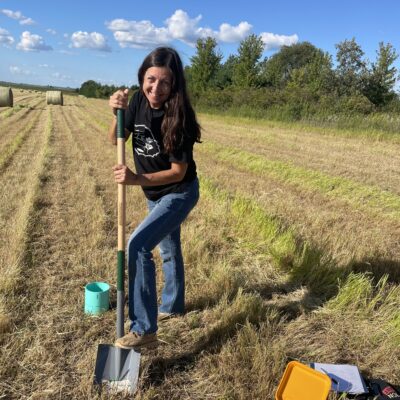
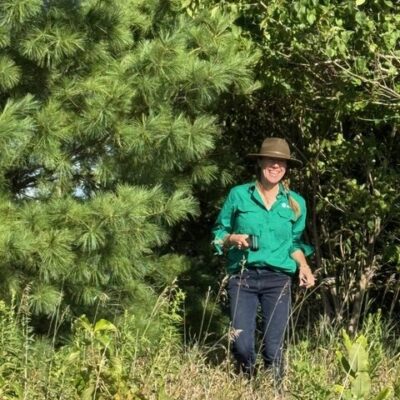
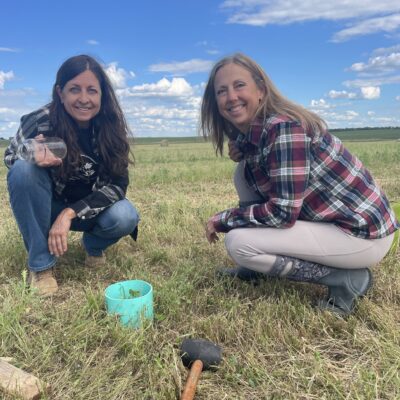
With hot coffee in hands, Sally, Chris and Katie discussed how healthy soils and diverse plant and animal landscapes support a series of living relationships that foster rain, and thus Nature’s ability to cool the Earth. Katie highlighted three important ways that the Earth can cool itself: 1) transpirative cooling, 2) cloud albedo, and 3) clear windows (without clouds, haze, or aerosols) at night for heat to re-radiate back out of the atmosphere.
- Transpirative Cooling Transpirative cooling is when vegetation transpires, taking the sun’s energy and using it to convert water into water vapor (changing sensible heat into latent heat). This water vapor (latent heat) rises into the atmosphere and is released higher in the sky when the water vapor condenses to form clouds, effectively removing heat from the Earth’s surface. On average, one tree has the cooling power of two air conditioners running at full capacity each day.
- Cloud Albedo Clouds also play an important role in how the Earth maintains an equal “energy budget” or how the Earth ensures the same amount of sun leaves our atmosphere as enters our atmosphere. Thick clouds act like a strong reflector – they bounce the sun’s energy back out to space. In other words, thick clouds have a high albedo. As diverse vegetation around the Earth has been removed, and thus cloud formation around the world has slowed, the Earth’s overall albedo has decreased, and more of the Sun’s energy enters the atmosphere. Living vegetation and soils are key to the formation of clouds.
- Nighttime re-radiation windows Another important way that the Earth can cool the landscape is through ‘nighttime re-radiation windows.’ A rain event not only cools the air, but it also clears the air of aerosols and particulate matter that can hold heat close to the Earth’s surface. So after a rain event, when the skies are clear at night, heat is more freely able to re-release out of our atmosphere.
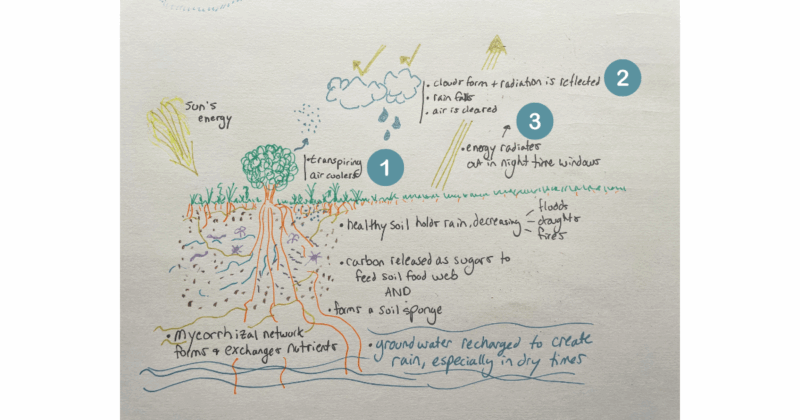
After a toe-dip discussion into these bio-climatology theories, Sally and her pup Sasha gave a tour of the substantial conservation that Sally and her father before her implemented across R Wildflower Farm & Fields’ 112 acres, including reforestation, ponding, restored native prairies, prescribed burns, perennial chemical-free pastures, and restored wetland, all of which help to restore soil and landscape health.
This restoration of soil and landscape health is essential, because restoring rain cycles and balancing local climates begins with healthy, living, functioning soils. So, in the afternoon, Sally, Chris, and Katie visited three sites on the farm to apply their curiosity to soil health. They started with simple questions involving the soils and their senses. How hard or soft is it? What life is visible in the soil? What does the soil smell like? How deep do the roots go? Do the roots have signs of a surrounding microbial community? These are all practical yet profound ways of enriching your relationship with, and knowledge of, your soil’s health and function.
As more specific demonstrations of the relationships between soil health, water cycles, and climate, they observed the temperatures of soil and air, as well as water infiltration across the three sites.
Temperature of the air and the soil surface indicates the degree to which transpiration and shade may be cooling the landscape, and whether the temperature of the soil is conducive to soil microbial life. In the forested area of the farm, the air and soil surface temperatures were 15 degrees cooler, and more moist, compared to the 85 degrees in the pastures. The cooler temperatures, shade, and ground litter keep the soil moist, which supports conditions for a thriving soil food web. The trio observed soil food web diversity in the forest, including caterpillars, ants, insects, earthworms, and fungi.
Whereas temperature indicates the direct impact vegetation can have in cooling the landscape, water infiltration illustrates how rain might move within and across the soils and landscape and thus be more or less available in drier times to keep the vegetation hydrated. In addition, the greater the soil microbial life, the more the soil structure functions like a sponge, allowing water to infiltrate and hold top soil in place.
To observe water infiltration, Sally, Chris, and Katie malleted a six-inch diameter PVC pipe down three inches into the soil. Then, they timed how long it took two separate batches of 450 mL of water to infiltrate. Depending on the level of moisture in the soil, the first pour will demonstrate the soil’s ability to absorb water from a dry state, in a short rain. As the first pour saturates the soil pores, the second pour can tell you more about how the soil will act in a longer rain event. Interestingly, at all three sites, the second pours of water were slower than the first, perhaps indicative of soils with higher silt levels, which can be easily compressed when wet.
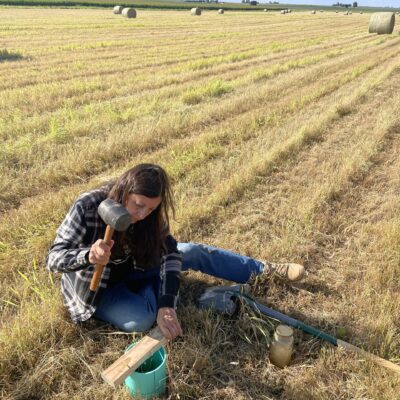
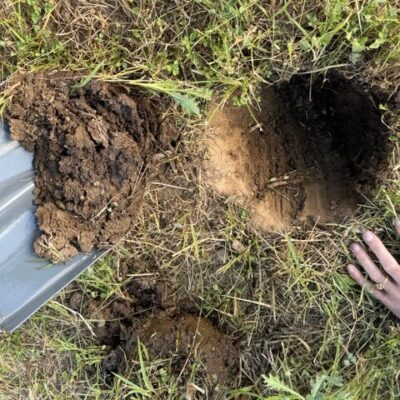
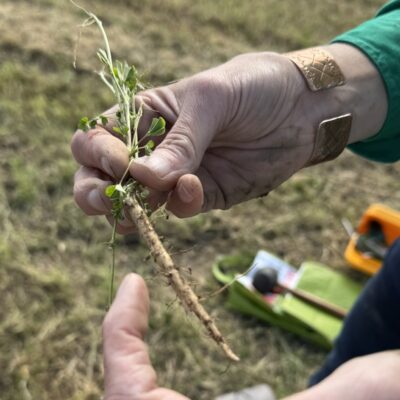
After the water infiltration, they shoveled out the soil under the water infiltration test to see what happened to the water – where it flowed or where in the soil horizon the water may have stopped infiltrating down, and how the water was distributed within the soils. And, they took the time to feel the soil structure, smell the soil for microbial life, and observe the depths of different soil horizons and roots.
In the pastures, the root depth appeared to be on average around 3-4 inches, and several roots started growing horizontally about 4 inches down, which could be highlighting some level of compaction that could be explored further with a penetrometer.
It’s important to remember that three qualities of soil can be investigated – physical (or structural), biological, and chemical, and that the water infiltration observations are just one aspect of a broad suite of soil structure observations. For example, previous testing at four sites across R Wildflower Farm & Fields by the Cornell Soil Health Laboratory showed ‘high’ and ‘very high’ functioning across physical and chemical properties, and on average, ‘medium’ functioning of biological. As the biological functioning increases across the farm, so will the soil’s structure, and water infiltration.
It’s also important to remember that standardised measurements serve a purpose, but the main benefit is getting to know your soils more intimately across seasons and across time, just as each farm can share infinitely unique and intimate stories of how life is thriving in their landscape. For Sally, these cherished moments include witnessing migrations of monarchs, fireflies illuminating her pastures, bullfrog serenades at night, migrating egrets and blue herons dotting her pond in the dawn’s pastel colors, and the mesmerizing movement of birds moving as one large fluid group over water and fields. It is clear that her restoration practices and avoiding chemical sprays for the last six years of ownership are allowing life to thrive.
Looking ahead, Sally hopes to reintegrate livestock into the perennial pastures, which will be more similar to the previous relationship between bison and the landscape from the time when the Peoria Nation were stewards.
According to John Kempf, these types of agriculture systems that mimic the perennial grasslands of the Great Plains demonstrate one of the best methods to build soil organic matter, especially as perennial grasses grow in health and root depth, and the soils grow in a fungally dominated ‘digestive system.’ To support plant health and fungal presence in the soil food web, Kempf recommends experimenting with importing of carbon, biological inoculums and biological stimulants (for example, via humates, biochar, compost).

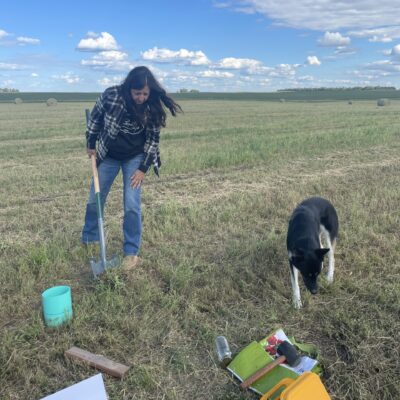

Perhaps just as important as stewardship of the landscape, though, is stewardship of good friendships over good food. This is the nourishment that gives us strength. Sally used the visit to organise a gathering of friends in the area who are all passionate about the connections between landscape and human health, at a farm-to-table eatery in Bloomington, where they shared stories of challenges and inspirations, with hearty laughter and hearty food in equal measure.
Dr. Katie Ross is an independent writer and researcher living on the homelands of the Menominee people in central Wisconsin (which means ‘river that meanders through something red’). She is very curious about how landscape restoration can be a profound point of agency to cool our climate, regenerate water cycles, grow nutritious food, foster biodiversity and reconnect with ourselves. Knowing how stories hold, transmit and transform paradigms, Katie is keen to explore these stories of regeneration.